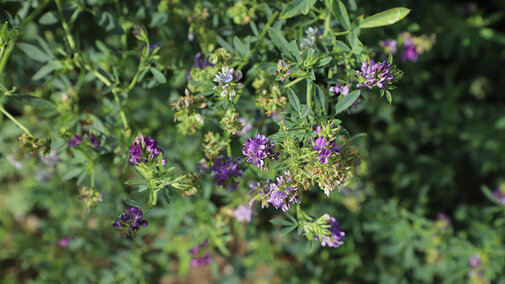Spring Planting Alfalfa
Alfalfa can be successfully seeded in the spring or fall depending on field weed pressure, moisture conditions and timing. Once established, perennial alfalfa plants can complete well with weeds. However, first year stand establishment can be a challenge when moisture is limited and weed pressure is high.
If herbicide-resistant weeds are currently growing in fields, then light tillage may be needed to control these weeds while creating a firm seedbed for alfalfa drilling. Also, combining light tillage plus herbicide may be a best management seedbed preparation practice.
Since new alfalfa seedlings are susceptible to injury from many herbicides, it is critical to follow all chemical label instructions. Usually, the alfalfa will need at least two to four trifoliated leaves before herbicides are applied, and 2,4-D usage is not recommended.
Glyphosate-tolerant or Round-up Ready alfalfa varieties provide more flexibility for controlling weeds currently growing in fields. Initial glyphosate application should occur between alfalfa emergence and fourth trifoliate leaf alfalfa growth stages to remove non-glyphosate tolerant alfalfa seedlings and control weeds that are present.
Our UNL “Seeding Alfalfa” NebGuide G2247 lists other steps for successfully establishing new alfalfa stands. For example, alfalfa grows best at 6.8 soil pH with a pH range from 6.5 to 7.5. Seed alfalfa between April 1 and May 15 in eastern and southern Nebraska, and sow seed between April 15 and May 15 in western and northern regions.
Target seeding depth is ¼-inch to ½-inch in the fine-textured soils and ¾-inch depth in sandy soils. Seedlings placed too shallow will dry out rapidly and die due to poor roots. Seeds planted more than 1 inch deep may be unable to emerge after germinating.
Winter Survival in Alfalfa
The time for spring planting alfalfa is just around the corner, and selecting the right seed is crucial. Two traits we should take extra time to consider are fall dormancy and winter survival. These traits are often treated the same but are different. Today, let’s look at winter survival.
Winter survival or winter hardiness is the ability for an alfalfa plant to make it through winter without injury once the plant goes dormant. This is different than the fall dormancy rating that measures the alfalfa’s ability to prepare for and recover from dormancy. Winter survival is measured on a 1 to 6 scale, with 1 being extremely hardy and 6 not hardy. For Nebraska, a winter survival rating of 3 is about as high as we want to go.
As temperatures drop and days shorten, alfalfa plants change their physiology to survive freezing temperatures and make it through winter. While increased hardiness can result in reduced yield potential for a high dollar perennial forage, having a full stand year after year is better in the long run.
In the past, winter survival traits were linked with fall dormancy. With new varieties, this isn’t always the case, so winter survival needs to be evaluated on its own.
We want to pick a winter survival ranking that will get us through winter without compromising yield. Where you are in the state plays a big role in what to pick. Winter temperatures affect the choice, but maintained snow cover is also important. As snow can help insulate the ground, parts of the state that regularly have open winters may need as high or higher survival rating than colder locations with winter-long snow cover.
Bottom line for Nebraska, a winter survival rating of 3 is about as high as we want to go and areas with open winters or regularly colder temperatures should be even lower.

